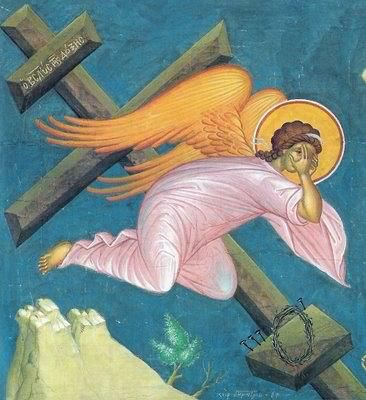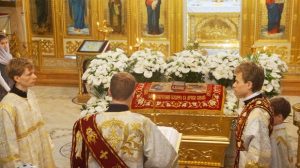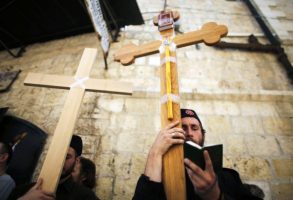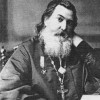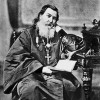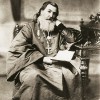Thus the burial rite has ended. We sang funeral hymns, ascended in our hearts to the heavens, and there sought resolution for our bewilderment of mind: how, to use the language of church hymnography, has the Uncontainable One been held fast by a sealed tomb? The Church now directs our gaze to the countenance of the Departed One resting in His tomb. Here, at the utmost limit of His abasement, under this veil of death, it points to the wondrous depths of the “Divine self-emptying” in His suffering and death on the Cross (Ode 4, Irmos). This Dead Man, enclosed in a tomb below the earth, is the sovereign Lord Who once covered with the waves of the sea those who persecuted and oppressed the fathers of His crucifiers and was later glorified by their songs of victory. The Church prompts us to look with trembling reverence upon this tomb, as upon an “ineffable wonder” (Ode 7, Irmos). The Omnipotent God, Who performed countless diverse miracles, “is laid in the tomb a lifeless corpse” for our salvation (Ode 7, Irmos). The Church draws our all our attention to this great event, which seizes heaven and the foundations of the earth with horror, for “He Who dwells in the highest is numbered among the dead, and welcomed in a little tomb” (Ode 8, Irmos).
In consideration of all this, the Church calls the present Saturday “Great.” It gives calm and peaceful expression to our feeling of grief. Here, at this tomb, it evokes in the soul sighs of quiet compunction that give wing to the sacred contemplation of the mysteries of Redemption and Resurrection. Christ Himself, in the person of His Mother, prohibits weeping and weariness. The tears of the Myrrhbearers are proper here, tears from which joy grows… These are all-forgiving tears, tears of the faithful soul conversing with Christ at His tomb, tears for the glorious victory of good over evil and truth over falsehood. At this tomb, the radiant conviction of the resurrection and eternal life befit the mind.
Before this tomb, the significance of human dignity and the complete destruction of the dread and fear of death increase. For we all have the Holy Spirit within us and, consequently, we shall all enter the gates of eternity. We are all filled with the grace of the Spirit of God, the Spirit of reason and wisdom and, consequently, we cannot but see with the eyes of faith that death is nothing but a dream. Dying is terrible for him who has lost the feeling of faith, hope, and love from his soul. But, by God’s grace, we all believe, love, and trust. For us, therefore, this tomb, these mortal veils, and this burial shroud are bright and divinely-revealing symbols and images, as the Apostle Paul says, of the trust that, when the earthly tabernacle of our body is dissolved, we will receive there, in the heavens, a different tabernacle, a house not made with hands and eternal (cf. 2 Corinthians 5:1).
Thus, the Savior commands us from the tomb to live without the fear of death, to progress in the Christian virtues, to labor in good deeds, and to attain perfection. Increase your inner happiness and fear neither old age nor death, for the Lord’s will is present with us in all things: evil, no matter how strong it might be, is weaker than good. As unpleasant as death may be, its influence is limited; beyond its limits, beyond the border of the grave, we have a heavenly fatherland; there will be activity and life after our hearts; this will be given us by Him in Whose honor we are now triumphantly singing funeral hymns of life and resurrection, for He said: he who believes shall have eternal life, for I am the resurrection and the life.












